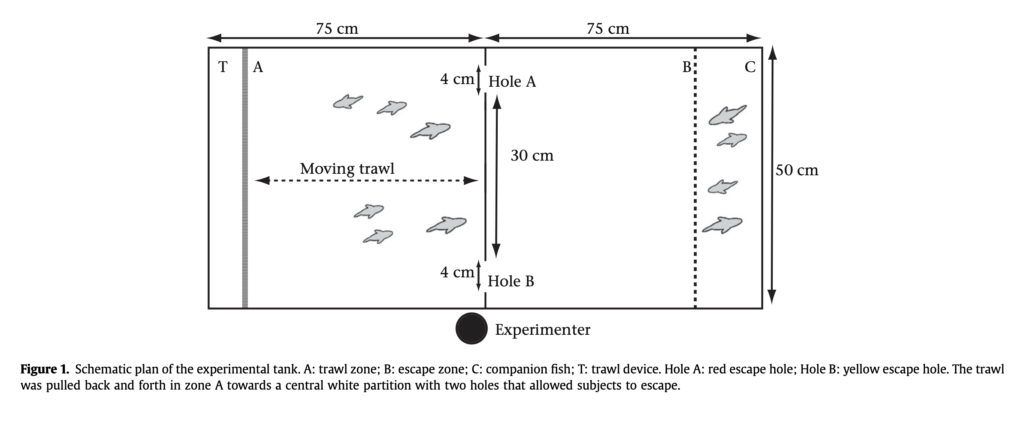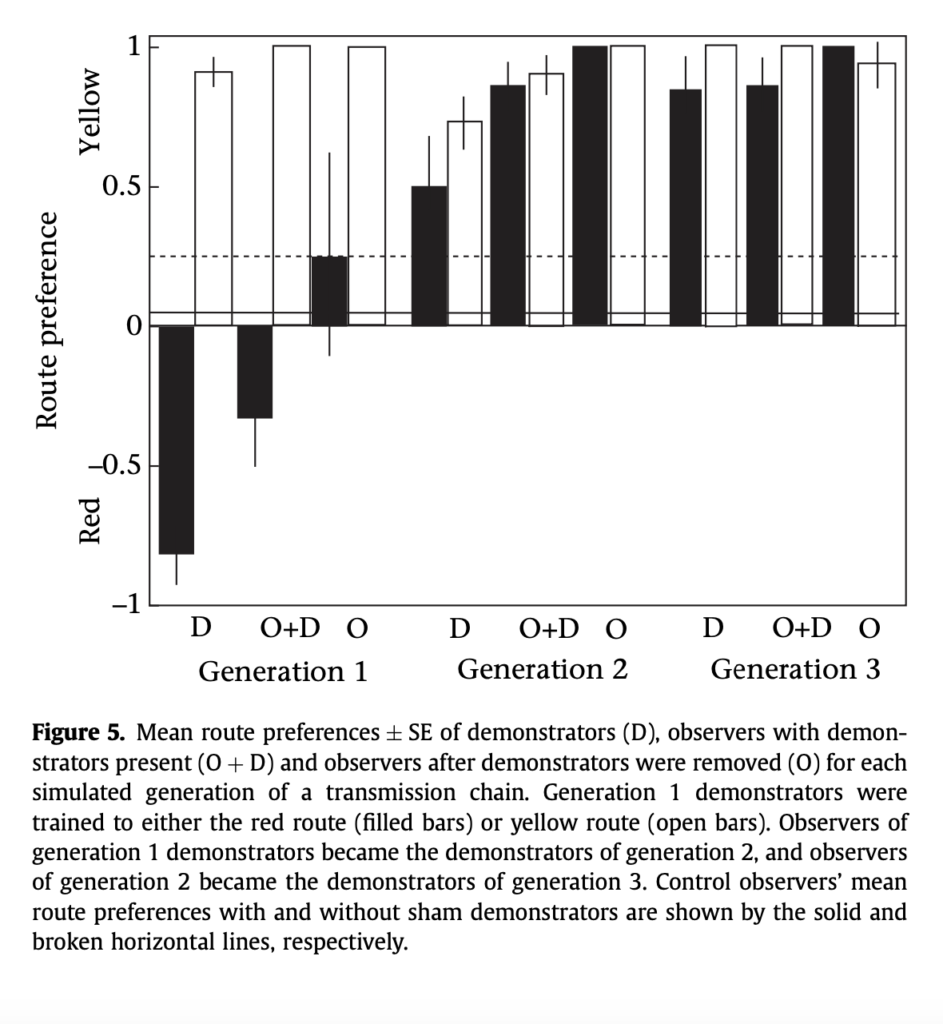What explains the stability of animal culture?
Recently, Dan Sperber and I published a paper entitled "Imitation explains the propagation, not the stability of animal culture" in which we argued that contrary to what is generally assumed, imitation and other forms of social learning are generally not faithful enough to explain the stability of culture we observe in the wild. A new article by Charlotte Lindeyer and Simon Reader in the last issue of Animal Behaviour reinforce our main argument. Lindeyer and Reader's article "Social learning of escape routes in zebrafish and the stability of behavioural traditions" uses a classical transmission chain paradigm in which several individuals (two, four or six depending on the condition) were trained to use one of two routes (Yellow vs. Red) to escape a moving trawl (see figure above). Once trained these individuals served as demonstrators during four trials for four naive fish placed in the tank with them. Demonstrators were then removed from the tank and naive fish underwent a session of four trials. The whole procedure was repeated with former observers acting as demonstrators for the next group of naive fish.
Lindeyer and Reader's article "Social learning of escape routes in zebrafish and the stability of behavioural traditions" uses a classical transmission chain paradigm in which several individuals (two, four or six depending on the condition) were trained to use one of two routes (Yellow vs. Red) to escape a moving trawl (see figure above). Once trained these individuals served as demonstrators during four trials for four naive fish placed in the tank with them. Demonstrators were then removed from the tank and naive fish underwent a session of four trials. The whole procedure was repeated with former observers acting as demonstrators for the next group of naive fish.
The main result of this experiment is that the difference between the Yellow and the Red condition disappears in only two transmission event (the difference between the two conditions is not significant at the second generation, see figure below). As the authors conclude, "... route choice decayed rapidly over generations. Thus, arbitrary information such as route use was not stably transmitted."
This study add another type of behaviour, escape choice, to the growing number of experiments using the transmission chain paradigm to determine the fidelity of social transmission in experimental conditions (other studies involve foraging decision, food choice, visual illusion, etc; reviewed in our article). So far not a single experiment using this paradigm has managed to demonstrate the persistence of cultural differences for more than 14 transmission steps. Hence our conclusion that social learning mechanisms are generally not faithful enough to explain the stability of culture we observe in the wild.
Some might wonder... if social learning mechanisms cannot explain cultural stability, what is involved then? This is not mysterious; A variety of factors affecting the persistence of behaviour in animal's repertoire can play a role in explaining the persistence of population specific behaviour in the wild. Ecological availability (the disponibility in nuts for nut cracking for instance), the rewarding effect of behaviour (e.g. efficient technique vs. less efficient one), content based psychological factors (such as learnability) and source based psychological factor (such as social proximity) are some obvious factors for which we have documented evidence of their influence on cultural stability (see our article for further references).
In view of these results it seems important to dissociate mechanisms explaining the appearance, the spread and the stability of behaviour from each other. The spread of new cultural behaviour is linked to social learning mechanisms whereas its persistence at the population level is associated with several different factors (ecological or psychological).
References
Claidière, N. and D. Sperber (2010). "Imitation explains the propagation, not the stability of animal culture." Proceedings of the Royal Society B: Biological Sciences 277(1681): 651-659.
Lindeyer, C. M. & Reader, S. M. 2010. Social learning of escape routes in zebrafish and the stability of behavioural traditions. Animal Behaviour, 79, 827-834
See also:
Thornton, A. and A. Malapert (2009). "The rise and fall of an arbitrary tradition: an experiment with wild meerkats." Proceedings of the Royal Society B: Biological Sciences 276(1660): 1269.
Galef, B. G. (1988). Imitation in Animals: History, Definition, and Interpretation of Data from the Psychological Laboratory. Social Learning Psychological and Biological Perspectives. T. R. Zentall and B. G. Galef. Hillsdale, New Jersey, Lawrence Erlbaum: 3-28.



